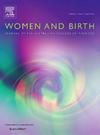Practice and knowledge of umbilical cord clamping of terms infants among midwives and obstetricians in Jordan: A national study
IF 4.1
2区 医学
Q1 NURSING
引用次数: 0
Abstract
Background
The absence of clinical guidelines on umbilical cord clamping may hinder evidence-based practice by midwives and obstetricians in Jordan.
Objective
To investigate current practices and knowledge among midwives and obstetricians regarding umbilical cord clamping for term infants and the influence of socio-demographic and professional factors.
Methods
This descriptive, cross-sectional study was conducted with 274 midwives and 51 obstetricians from 25 public hospitals that provide intrapartum care in Jordan. A paper-based questionnaire assessed current practices and knowledge regarding umbilical cord clamping.
Results
Most midwives and obstetricians (69.8 %) reported routinely performing early cord clamping for term infants (within < 1 minute of childbirth). Around 61 % of participants reported poor knowledge regarding the benefits of delayed cord clamping. While participants with Bachelor and higher degree level education achieved higher knowledge scores, age was inversely correlated. Participants aged over 30 years, with more than 5 years’ experience, diploma level qualifications, obstetricians, and those with poor knowledge were more likely to perform early cord clamping.
Conclusion
Around two-thirds of midwives and obstetricians reported poor knowledge regarding the benefits of delayed cord clamping and were more likely to perform early cord clamping. Results highlight the need for national guidelines in Jordan in conjunction with continued education and training regarding umbilical cord clamping.
约旦助产士和产科医生对足月婴儿脐带夹紧的实践和知识:一项全国性研究
背景:缺乏脐带夹临床指南可能会阻碍约旦助产士和产科医生的循证实践。目的了解助产士和产科医生对足月儿脐带夹的认识现状及社会人口统计学和专业因素的影响。方法对约旦25家提供产时护理的公立医院的274名助产士和51名产科医生进行了描述性横断面研究。一份纸质问卷评估了目前脐带夹紧的做法和知识。结果大多数助产士和产科医生(69.8% %)报告常规对足月婴儿进行早期脐带夹紧术(在<;1 分娩分钟)。大约61 %的参与者报告对延迟脐带夹紧的好处知之甚少。本科及以上学历的参与者在知识方面得分较高,而年龄则呈负相关。参与者年龄在30岁以上,经验在5年以上,具有文凭水平的资格,产科医生和知识较差的人更有可能进行早期脐带夹紧。结论约三分之二的助产士和产科医生报告对延迟脐带夹的好处知之甚少,更有可能进行早期脐带夹。结果突出表明,约旦需要制定国家指南,并结合脐带夹持的继续教育和培训。
本文章由计算机程序翻译,如有差异,请以英文原文为准。
求助全文
约1分钟内获得全文
求助全文
来源期刊

Women and Birth
NURSING-OBSTETRICS & GYNECOLOGY
CiteScore
7.20
自引率
13.20%
发文量
371
审稿时长
27 days
期刊介绍:
Women and Birth is the official journal of the Australian College of Midwives (ACM). It is a midwifery journal that publishes on all matters that affect women and birth, from pre-conceptual counselling, through pregnancy, birth, and the first six weeks postnatal. All papers accepted will draw from and contribute to the relevant contemporary research, policy and/or theoretical literature. We seek research papers, quality assurances papers (with ethical approval) discussion papers, clinical practice papers, case studies and original literature reviews.
Our women-centred focus is inclusive of the family, fetus and newborn, both well and sick, and covers both healthy and complex pregnancies and births. The journal seeks papers that take a woman-centred focus on maternity services, epidemiology, primary health care, reproductive psycho/physiology, midwifery practice, theory, research, education, management and leadership. We also seek relevant papers on maternal mental health and neonatal well-being, natural and complementary therapies, local, national and international policy, management, politics, economics and societal and cultural issues as they affect childbearing women and their families. Topics may include, where appropriate, neonatal care, child and family health, women’s health, related to pregnancy, birth and the postpartum, including lactation. Interprofessional papers relevant to midwifery are welcome. Articles are double blind peer-reviewed, primarily by experts in the field of the submitted work.
 求助内容:
求助内容: 应助结果提醒方式:
应助结果提醒方式:


